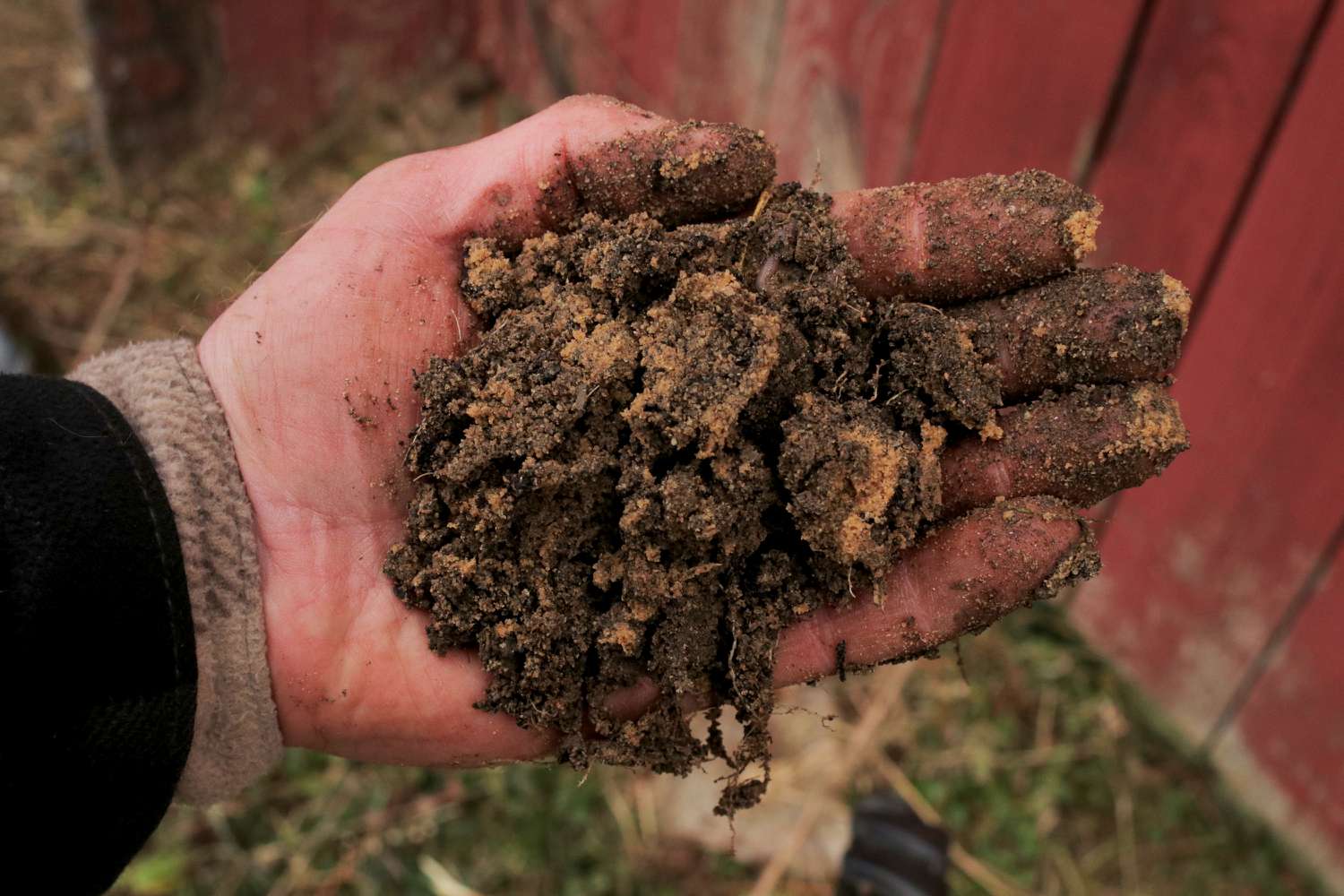Home>Gardening News and Trends>What Happens If You Use Too Much Fertilizer


Gardening News and Trends
What Happens If You Use Too Much Fertilizer
Published: August 5, 2023
Discover the consequences of excessive fertilizer use in this latest news update. Learn about the potential impacts on soil health, plant growth, and the environment.
(Many of the links in this article redirect to a specific reviewed product. Your purchase of these products through affiliate links helps to generate commission for Chicagolandgardening.com, at no extra cost. Learn more)
Table of Contents
Introduction
Fertilizers are an essential tool for promoting healthy plant growth and maximizing crop yields. They provide the necessary nutrients that plants need to thrive, ensuring optimal development and productivity. However, it is crucial to apply fertilizers in the correct quantities and at the appropriate times. Using too much fertilizer can have adverse effects on the environment and the overall health of the soil and plants.
In this article, we will explore the consequences of excessive fertilizer usage and its potential impacts. Understanding these effects is essential for maintaining sustainable agricultural practices and minimizing environmental damage.
Proper fertilizer management is crucial for several reasons. Firstly, excess fertilizer can contribute to nutrient runoff, leading to water pollution. When it rains or when irrigation water is applied, excess nutrients can wash away, entering streams, rivers, and eventually, larger bodies of water. This can result in the proliferation of harmful algal blooms, which can deplete oxygen levels in the water and harm aquatic life.
Additionally, excessive fertilizer applications can adversely affect soil health. Fertilizers contain concentrated amounts of nutrients, and if too much is applied, it can create an imbalance in the soil. This can lead to nutrient leaching, where essential elements are washed away from the root zone, making them unavailable to plants. It can also result in nutrient buildup, which can be toxic to plants and disrupt the soil’s natural ecosystem.
Furthermore, nutrient imbalances caused by excessive fertilizer use can adversely impact plant health. When certain nutrients are over-applied, it can interfere with the uptake of other necessary elements. This can hinder overall plant growth and development, leading to stunted growth, reduced yield, or even plant death.
To ensure the long-term sustainability of fertilizer usage, it is crucial to adopt proper fertilization practices. This includes conducting soil tests to determine the nutrient needs of the soil and implementing targeted fertilization plans. Furthermore, using slow-release or controlled-release fertilizers can help minimize nutrient losses and optimize nutrient availability to plants.
In the following sections, we will delve deeper into the effects of excessive fertilizer application on the environment, soil, and plant health. By understanding these consequences, we can take appropriate measures to strike a balance between promoting vigorous plant growth and safeguarding the ecosystem.
Understanding Fertilizer Usage
Fertilizers play a crucial role in agriculture by providing essential nutrients to plants that are necessary for their growth, development, and productivity. They supplement the natural nutrient levels in the soil, ensuring that plants have access to the elements they need to thrive. However, it is important to understand how fertilizers work and why proper usage is so vital.
Fertilizers contain a combination of macro and micronutrients that are essential for plant nutrition. The primary macronutrients include nitrogen (N), phosphorus (P), and potassium (K), often referred to as NPK. These nutrients are required in larger quantities and play a vital role in various plant functions. In addition to the macronutrients, fertilizers may also contain secondary nutrients like calcium (Ca), magnesium (Mg), and sulfur (S), as well as micronutrients like iron (Fe), manganese (Mn), zinc (Zn), copper (Cu), boron (B), and molybdenum (Mo).
When plants lack these essential nutrients, their growth can be stunted, and they may have poor yields or be more susceptible to diseases and pests. Fertilizers help to address these deficiencies by replenishing the nutrients in the soil, providing plants with the necessary elements to flourish.
However, it is crucial to use fertilizers judiciously and in line with the specific requirements of the plants being cultivated. Applying too much fertilizer can lead to excessive nutrient accumulation in the soil, which can have detrimental effects.
Moreover, the timing and method of fertilizer application are key considerations. Some fertilizers are designed for pre-planting application, while others can be applied during crop growth stages. Understanding the specific nutrient requirements of the plants, as well as the optimal timing and placement of fertilizers, ensures that the nutrients are available to the plants when they need them the most.
Soil type and conditions also play a role in determining the appropriate fertilizer usage. Different soils have varying nutrient-holding capacities, so it is essential to consider the nutrient availability and leaching potential of the soil when determining the fertilizer dosage. Conducting soil tests can help determine the existing nutrient levels and guide fertilization decisions to avoid over-application.
Ultimately, understanding fertilizer usage involves a combination of factors, including the specific nutrient needs of the plants, soil conditions, and environmental considerations. By adopting proper fertilization practices, farmers and gardeners can ensure optimal plant growth while minimizing the negative impacts of excessive fertilization on the environment and overall soil health.
Effects of Excessive Fertilizer Application
While fertilizers are essential for promoting plant growth and maximizing yields, using excessive amounts can have detrimental effects on the environment, soil health, and plant growth. Understanding these consequences is crucial for sustainable agricultural practices and minimizing negative impacts.
One of the primary effects of excessive fertilizer application is environmental pollution. When fertilizers are over-applied, the excess nutrients can seep into groundwater or be carried away by surface runoff during rain events. These nutrients, particularly nitrogen and phosphorus, can enter water bodies, causing eutrophication. Eutrophication is the excessive growth of algae and aquatic plants, which depletes oxygen levels in the water and negatively impacts fish and other aquatic organisms.
Excessive fertilizer usage can also lead to soil degradation. When an abundance of nutrients is present in the soil, it can disrupt the natural balance and lead to nutrient imbalances. This can hinder microbial activity, reduce organic matter, and change the soil structure, ultimately impacting overall soil health and fertility. Additionally, the excess nutrients can get washed away from the root zone, rendering them unavailable to plants and leading to nutrient losses.
Another consequence of excessive fertilization is the risk of nutrient toxicity. Certain nutrients, such as nitrogen and potassium, can be harmful to plants when applied in excessive amounts. These excess nutrients can accumulate in plant tissues, causing toxicity symptoms such as leaf burn, stunted growth, and nutrient imbalances. Additionally, excessive nitrogen fertilization can also contribute to increased pest and disease susceptibility in plants.
Moreover, excessive fertilizer usage can result in economic losses for farmers. Overspending on fertilizers without considering the actual nutrient requirements of the crops can lead to unnecessary expenses and reduced profitability. It is essential for farmers to adopt precision agriculture techniques, such as soil testing and nutrient management plans, to optimize fertilizer usage and maximize crop yield.
It is clear that excessive fertilizer application can have significant negative impacts on the environment, soil health, plant growth, and the economy. To mitigate these effects, it is crucial to adopt responsible fertilization practices. Farmers and gardeners should carefully calculate the nutrient requirements of their crops, based on soil tests and plant tissue analysis, to ensure that fertilizers are applied in the right amounts and at the proper times.
Implementing best practices, such as using slow-release or controlled-release fertilizers, can also help minimize nutrient losses and ensure that nutrients are released to plants gradually and efficiently. Additionally, precision agriculture technologies, such as site-specific nutrient management, can assist in optimizing fertilizer usage and reducing environmental impacts.
By being mindful of the potential consequences of excessive fertilizer application and embracing sustainable fertilization practices, we can strike a balance between promoting healthy plant growth and safeguarding our environment for future generations.
Environmental Impacts
Excessive fertilizer application can have significant environmental impacts, particularly in terms of water pollution and ecosystem disruption. It is crucial to understand these consequences to take appropriate measures and minimize the detrimental effects on our environment.
One of the primary environmental impacts of excessive fertilizer usage is nutrient runoff. When fertilizers are applied in excess or during inappropriate weather conditions, such as before heavy rainfall, the excess nutrients can be washed away by surface runoff or leach into groundwater. This nutrient runoff can enter nearby streams, rivers, and eventually larger bodies of water, leading to water pollution.
The main culprits in nutrient runoff are nitrogen (N) and phosphorus (P), which are common components of fertilizers. Once these nutrients enter water bodies, they can cause a process called eutrophication. Eutrophication occurs when there is an abundance of nutrients in the water, promoting the excessive growth of algae and other aquatic plants. This rapid growth depletes oxygen levels in the water, leading to the death of fish and other aquatic organisms.
Additionally, excessive nutrient levels can create harmful algal blooms, which release toxins into the water. These toxins pose dangers to both humans and wildlife. For example, some algal blooms produce toxins that can contaminate drinking water sources and endanger public health.
Furthermore, nutrient runoff can have long-term impacts on marine ecosystems. Excess nutrients can promote the growth of invasive species, which can outcompete native marine organisms and disrupt the delicate balance of the ecosystem. This can have cascading effects on the food chain and biodiversity of the affected area.
Excessive fertilizer usage can also contribute to air pollution. When nitrogen-based fertilizers are applied, some of the nitrogen can volatilize into the atmosphere as ammonia gas. This ammonia can react with other pollutants in the air, such as sulfur dioxide and nitrogen oxides, to form particulate matter and contribute to air pollution. These pollutants have detrimental effects on air quality and can contribute to respiratory issues and other health problems in humans and animals.
To mitigate these environmental impacts, several measures can be taken. Efficient and targeted fertilizer use, based on soil tests and plant nutrient requirements, can help minimize nutrient losses. Applying fertilizers at the appropriate times, such as when there is less likelihood of runoff or leaching, can also reduce the risk of water pollution.
Implementing conservation practices, such as buffer strips and cover crops, can help prevent nutrient runoff by allowing vegetation to absorb and utilize the excess nutrients before they reach water bodies. Additionally, adopting precision agriculture techniques, such as site-specific nutrient management and variable rate application, can optimize fertilizer usage and minimize environmental impacts.
By being mindful of the environmental consequences and employing responsible fertilization practices, we can help protect our water bodies, preserve biodiversity, and reduce air pollution. Sustainable agricultural practices that prioritize environmental stewardship are essential for ensuring a healthy and thriving ecosystem for generations to come.
Soil and Plant Health
Excessive fertilizer application can have detrimental effects on both soil health and plant growth. It is crucial to understand these impacts to maintain the long-term sustainability of agricultural practices and ensure the vitality of plants and the soil ecosystem.
One of the primary concerns with excessive fertilizer usage is nutrient imbalance in the soil. Fertilizers are designed to provide specific nutrients to plants, but over-application can lead to an imbalance in nutrient availability. This imbalance can result in nutrient excesses or deficiencies, both of which can negatively impact plant health. Additionally, an imbalance in nutrients can disrupt microbial activity in the soil, impacting the natural nutrient cycling processes.
Excessive fertilizer usage can also lead to nutrient leaching. When fertilizers are over-applied, the excess nutrients can move beyond the root zone and be washed away by rainfall or irrigation water. This leaching process can result in the loss of essential nutrients from the soil, making them unavailable to plants. This loss of nutrients can impair plant growth and decrease crop yields over time.
Furthermore, excessive fertilizer application can contribute to soil acidification. Fertilizers, particularly nitrogen-based ones, can increase the acidity of the soil over time. This can negatively affect soil structure, microbial activity, and nutrient availability, ultimately impacting plant growth. Acidic soils can also result in the leaching of essential nutrients, such as calcium and magnesium, further exacerbating nutrient imbalances.
Moreover, excessive fertilization can reduce the natural fertility of the soil. When plants receive an excess of nutrients from external sources like fertilizers, they rely less on their symbiotic relationships with beneficial soil organisms, such as mycorrhizal fungi. These organisms help improve nutrient uptake and overall plant health. Over time, the soil ecosystem can become less resilient, leading to decreased soil fertility and biodiversity.
To mitigate the negative impacts of excessive fertilizer application on soil and plant health, several practices can be employed. Conducting regular soil tests can help assess nutrient levels and guide fertilizer application to match the specific needs of the plants and soil. This ensures efficient nutrient utilization and reduces the risk of nutrient imbalances.
Applying fertilizers at the appropriate times and in the right amounts can help minimize nutrient losses and prevent leaching. Additionally, using slow-release or controlled-release fertilizers provides a more gradual and sustained release of nutrients, optimizing nutrient availability to plants without overloading the soil.
Implementing organic farming practices, such as incorporating organic matter, cover crops, and crop rotation, can help enhance the soil’s natural fertility and microbial activity. These practices promote nutrient cycling, improve soil structure, and increase water-holding capacity, creating a more resilient and healthy soil ecosystem.
By adopting responsible fertilization practices and prioritizing soil and plant health, farmers and gardeners can sustainably manage their agricultural systems and maximize crop productivity without compromising the long-term health and integrity of the soil.
Nutrient Imbalances
Nutrient imbalances can occur when excessive amounts of fertilizers are applied, causing an uneven distribution of essential nutrients in the soil. These imbalances can have significant impacts on plant health, growth, and overall productivity. It is important to recognize and address nutrient imbalances to maintain optimal crop performance and sustainability.
Excessive nitrogen (N) application, for example, can lead to an imbalance in macronutrients. High levels of nitrogen promote rapid vegetative growth, often at the expense of other nutrients. This can result in deficiencies of essential nutrients such as phosphorus (P), potassium (K), and micronutrients. The excessive growth stimulated by nitrogen can also make plants more susceptible to diseases and pests.
Similarly, excessive phosphorus application can lead to nutrient imbalances. Phosphorus is vital for root development, flowering, and fruiting. However, over-application can cause an imbalance, inhibiting the uptake of other essential nutrients such as iron (Fe) and manganese (Mn). This can manifest as nutrient deficiencies and negatively impact plant growth and yield.
Another nutrient commonly affected by imbalances is potassium. Too much potassium can hinder the absorption of calcium (Ca) and magnesium (Mg) by plants, leading to deficiencies of these nutrients. Imbalanced potassium levels can result in disorders such as calcium deficiency-related disorders in crops like tomatoes and peppers.
Micronutrient imbalances can also occur with excessive fertilizer usage. Some micronutrients, like iron (Fe), copper (Cu), and zinc (Zn), are essential for various plant physiological processes. However, excessive levels of one micronutrient can lead to antagonistic interactions with other micronutrients, limiting their availability to plants and causing nutrient imbalances.
Addressing nutrient imbalances requires careful monitoring and adjustment of fertilization practices. Regular soil testing is essential for understanding the nutrient composition of the soil and identifying any deficiencies or excesses. This information can guide fertilization decisions and help tailor nutrient applications to ensure a balanced nutrient profile in the soil.
Adopting a targeted fertilization approach, such as using fertilizers with specific nutrient ratios, can help rectify imbalances. This ensures that the right amounts of essential nutrients are provided to maintain a harmonious nutrient balance in the soil for plant uptake.
In addition to fertilizer adjustments, other management strategies can assist in mitigating nutrient imbalances. Crop rotation, for example, helps break any cycles of nutrient overloading or depletion by diversifying the nutrient demands of different crop varieties. Incorporating organic matter, such as compost or cover crops, can contribute to nutrient and organic material recycling, enhancing nutrient availability and improving soil health.
By addressing nutrient imbalances through proper fertilization strategies and holistic soil management practices, farmers can optimize nutrient utilization, promote healthy plant growth, and ultimately achieve sustainable and productive agricultural systems.
Tips for Proper Fertilizer Application
Proper fertilizer application is key to ensuring efficient nutrient utilization, maintaining soil health, and promoting optimal plant growth. By following these tips, farmers and gardeners can improve fertilizer management and minimize the negative impacts of excessive usage:
- Conduct Soil Testing: Regular soil testing is essential for understanding the nutrient composition of the soil. It helps identify any deficiencies or excesses, allowing for targeted fertilization. Soil tests provide valuable information about the pH levels, organic matter content, and nutrient levels in the soil.
- Calculate Nutrient Requirements: Based on soil test results and crop nutrient requirements, calculate the optimal amount of fertilizers needed. Consider the specific nutrient needs of the crops being cultivated, taking into account factors such as growth stage, yield goals, and soil nutrient availability.
- Timing: Apply fertilizers at the appropriate times during the plant’s growth cycle. Pre-planting fertilization can help prepare the soil for optimal nutrient availability, while top-dressing or side-dressing applications can ensure nutrients are provided during critical growth stages. Avoid applying fertilizers during periods of heavy rainfall to reduce the risk of nutrient runoff.
- Fertilizer Placement: Consider the placement of fertilizers to maximize nutrient uptake by the plants. Incorporate granular fertilizers into the soil during planting or apply them directly to the root zone. This helps ensure that nutrients are in close proximity to the plant roots for efficient absorption.
- Use Slow-release Fertilizers: Utilize slow-release or controlled-release fertilizers that release nutrients gradually over time. These types of fertilizers can help minimize nutrient losses and reduce the risk of nutrient imbalances in the soil.
- Maintain Proper Storage: Store fertilizers in a cool and dry location to prevent nutrient degradation. Proper storage conditions help maintain the effectiveness and quality of the fertilizers.
- Consider Environmental Factors: Take into account environmental conditions, such as weather patterns and soil moisture levels, when determining fertilizer application rates. Adjust fertilizer quantities based on factors like rainfall, irrigation practices, and the specific needs of the plants.
- Monitor and Evaluate: Regularly monitor plant health and growth to assess the effectiveness of fertilizer applications. Look for any signs of nutrient deficiencies or excesses and adjust fertilization practices accordingly.
- Adopt Precision Agriculture Techniques: Embrace precision agriculture technologies, such as site-specific nutrient management and variable rate application, to optimize fertilizer usage. These technologies help tailor fertilization to the specific nutrient requirements of different areas within a field, minimizing over-application and reducing environmental impacts.
- Consider Organic Options: Explore organic alternatives, such as compost or organic fertilizers, to supplement nutrient requirements. Organic fertilizers provide slow-release nutrients and improve soil structure, promoting long-term soil health.
By following these tips, farmers and gardeners can ensure responsible fertilizer application, optimizing nutrient availability to plants while safeguarding the environment and maintaining the long-term sustainability of their agricultural practices.
Conclusion
Proper fertilizer application is essential for promoting healthy plant growth, maximizing yields, and maintaining the long-term sustainability of agricultural practices. However, using excessive amounts of fertilizers can lead to detrimental effects on the environment, soil health, and plant growth.
Excessive fertilizer usage can contribute to water pollution through nutrient runoff, causing eutrophication and the proliferation of harmful algal blooms. It can also degrade soil health by disrupting nutrient balances, increasing soil acidity, and decreasing natural soil fertility. Nutrient imbalances can hinder plant growth and productivity, leading to decreased crop yields and economic losses.
To counteract these negative impacts, it is crucial to adopt responsible fertilization practices. Conducting regular soil tests, calculating nutrient requirements, and applying fertilizers at the appropriate times and in the right amounts help maintain a balanced nutrient profile in the soil. Using slow-release or controlled-release fertilizers can reduce nutrient losses and optimize nutrient availability to plants.
Environmental considerations, such as avoiding excessive nutrient runoff and minimizing air pollution, are vital. Conservation practices like buffer strips, cover crops, and precision agriculture techniques can aid in reducing the environmental footprint of fertilizer usage. Additionally, incorporating organic farming practices and using organic alternatives can enhance soil health and nutrient recycling.
By following these guidelines, farmers and gardeners can strike a balance between promoting healthy plant growth and minimizing the negative impacts of excessive fertilization. The result is sustainable agricultural systems that optimize nutrient utilization, safeguard the environment, enhance soil health, and ensure the long-term productivity and resilience of our crops and ecosystems.










